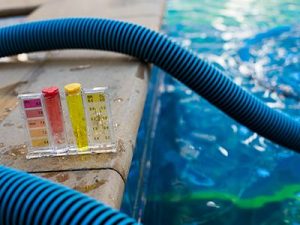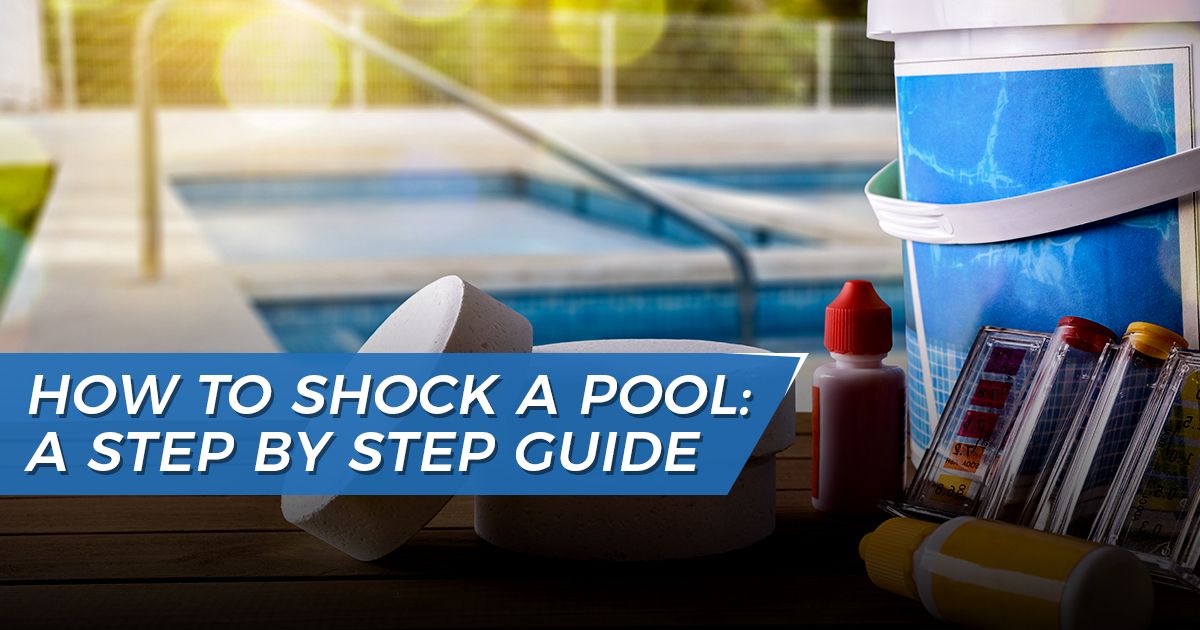How To Shock a Pool: A Step By Step Guide
Every pool owner knows that crystal clear, clean water doesn’t happen without consistent maintenance. Even with routine chlorination, it is necessary to frequently perform a pool shock treatment. If you’re not quite sure what that entails, don’t worry, we’re giving you the rundown on how to shock your pool.
Environmental factors such as sunlight and heat can interact with pool chemicals, which is why routine testing and chemical balancing is so important. When it comes to swimming pool chemicals and chemistry, there are two main levels to consider. The first involves balancing pH levels to ensure the water is kept in the neutral zone and the second involves sanitizing the water to ensure it is free from harmful bacteria.
When to Perform a Pool Shock Treatment
 You know that overwhelming smell that drifts down hotel hallways and reminds you that there is a heavily chlorinated pool nearby? Well, that smell isn’t actually the smell of chlorine, it’s chloramines. Chloramines are what form when chlorine comes in contact with bodily fluids such as sweat or urine. So, what you’re really smelling is an improperly treated pool. To prevent that from happening to your own pool, it’s important to regularly shock your pool system. We recommend doing this at least once a month. However, if it has rained a lot, been extremely hot and sunny, or your pool is heavily used, a weekly shock is encouraged to maintain proper sanitation.
You know that overwhelming smell that drifts down hotel hallways and reminds you that there is a heavily chlorinated pool nearby? Well, that smell isn’t actually the smell of chlorine, it’s chloramines. Chloramines are what form when chlorine comes in contact with bodily fluids such as sweat or urine. So, what you’re really smelling is an improperly treated pool. To prevent that from happening to your own pool, it’s important to regularly shock your pool system. We recommend doing this at least once a month. However, if it has rained a lot, been extremely hot and sunny, or your pool is heavily used, a weekly shock is encouraged to maintain proper sanitation.
Understanding Chlorine Levels
The good news is you don’t have to wait for the strong smell of chloramines to know it’s time to bump up the chemicals. Home chlorine tests can help you identify when it’s time for a shock by testing your combined and free chlorine levels. Before we dive into the details of how, it’s important to know what the different measures of chlorine mean.
Free Chlorine (FC): the amount of chlorine that is currently disinfecting your pool. This should be between one and four parts per million (ppm).
Combined Chlorine (CC): the amount of chlorine that has already been used and is no longer effectively functioning, but is still present in the water. This should be under 0.2 ppm. Since home testing kits only measure FC and TC you can subtract FC from TC to get the CC level.
Total Chlorine (TC): This is the total amount of chlorine in your pool or the sum of Free Chlorine and Combined Chlorine.
When shocking your pool, it’s important to reach Breakpoint Chlorination, which means you’ve added enough Free Chlorine to break up the chloramines. This process usually requires adding ten times the chlorine that you normally would in order to shock the water and kill any harmful bacteria. Failing to reach Breakpoint Chlorination means that chloramines will remain in your pool, and if left untreated, you’ll eventually have to replace your pool water in its entirety.
Different Pool Shock Treatments
Although chlorine is most commonly used to shock pools, there are a number of pool shock treatments with varying levels of chlorine. It’s important to understand the differences before heading to the store, to ensure you select the best one for your pool needs.
Calcium Hypochlorite
This is one of the easiest and most inexpensive chemicals you can use to shock your pool. It generally contains 65 – 75% of chlorine and must be dissolved in water before it’s added to your pool. Since it reacts with sunlight, it should be administered at night and swimmers should avoid the water for at least eight hours after treatment.
Lithium Hypochlorite
Although this treatment is a bit more expensive than calcium hypochlorite, it can be added directly to your pool water which makes it a bit easier to use. It has significantly lower levels of chlorine (35%), but still must be administered after dark and swam in no earlier than eight hours post-treatment. It’s important to note that this chemical can be toxic to aquatic life, so disposing of recently treated water must be done responsibly.
Dichlor
This treatment contains between 50-60% chlorine and can be directly added to water or diluted, depending on the brand used. The major benefit of using dichlor is that it can be used for regular chlorination and shock treatments, which can save you a trip to the pool store. Again, this treatment must be done after dusk and an eight-hour wait period is necessary before use.
Non-Chlorine (Potassium Peroxymonosulfate) Shock
The last pool shock treatment doesn’t include any form of chlorine. This method is best for those who want to avoid the post-treatment wait period. You can generally use the pool within 20 minutes of this treatment and it can be added directly to the water.
How To Shock a Pool
Now that we’ve given you a bit of a chemistry lesson, let’s dive into the process. For most pool shock treatments, you’ll need a bucket, chemical testing kit, and protective gear in case you experience splashback.
Step 1: Test your pool water to determine your CC levels. This will help you figure out how much shock you need. Most manufacturers will include a chart or instructions on how to calculate the level of shock needed for your pool.
Step 2: If your specific pool shock treatment cannot be added directly to the pool water, dilute it in a large (five-gallon) bucket of pool water. It’s important to slowly add the shock to the bucket and never add water to the shock. Stir slowly until the chemicals are dissolved.
*If you do not need to dilute your shock treatment, gradually add the chemicals directly to your pool water until the calculated breakpoint is reached.
Step 3: Make sure your filtration system is running and slowly pour the bucket into the pool, ideally in front of a return line fitting. This will ensure the chemicals are pushed by the jet stream into the center of your pool. Alternatively, you can slowly pour while walking around the pool.
Step 4: Once there is a quarter of the solution left in your bucket, you’ll want to add more pool water, mix again and add to the pool water to ensure all of the chemicals have been dissolved.
Step 5: Once you’ve used all of the required shock, you’ll need to ensure no one enters the pool until the chlorine levels are around 3 ppm. This can take up to 24-hours after a treatment, unless you are using a non-chlorinated shock.
No Hassle For You
If chemistry was never your strong suit, don’t worry. We are more than equipped to perform the procedure for plus any additional pool cleaning services you might need. Our certified technicians will thoroughly test your pool’s chemistry and do whatever is needed to keep it balanced. Call us today and we’ll take care of your pool’s shock treatments and ensure it is safe for everyone who uses it.

